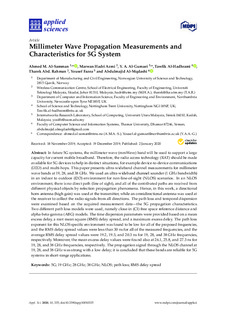| dc.description.abstract | In future 5G systems, the millimeter wave (mmWave) band will be used to support a large capacity for current mobile broadband. Therefore, the radio access technology (RAT) should be made available for 5G devices to help in distinct situations, for example device-to-device communications (D2D) and multi-hops. This paper presents ultra-wideband channel measurements for millimeter wave bands at 19, 28, and 38 GHz. We used an ultra-wideband channel sounder (1 GHz bandwidth) in an indoor to outdoor (I2O) environment for non-line-of-sight (NLOS) scenarios. In an NLOS environment, there is no direct path (line of sight), and all of the contributed paths are received from different physical objects by refection propagation phenomena. Hence, in this work, a directional horn antenna (high gain) was used at the transmitter, while an omnidirectional antenna was used at the receiver to collect the radio signals from all directions. The path loss and temporal dispersion were examined based on the acquired measurement data—the 5G propagation characteristics. Two different path loss models were used, namely close-in (CI) free space reference distance and alpha-beta-gamma (ABG) models. The time dispersion parameters were provided based on a mean excess delay, a root mean square (RMS) delay spread, and a maximum excess delay. The path loss exponent for this NLOS specific environment was found to be low for all of the proposed frequencies, and the RMS delay spread values were less than 30 ns for all of the measured frequencies, and the average RMS delay spread values were 19.2, 19.3, and 20.3 ns for 19, 28, and 38 GHz frequencies, respectively. Moreover, the mean excess delay values were found also at 26.1, 25.8, and 27.3 ns for 19, 28, and 38 GHz frequencies, respectively. The propagation signal through the NLOS channel at 19, 28, and 38 GHz was strong with a low delay; it is concluded that these bands are reliable for 5G systems in short-range applications. | nb_NO |

